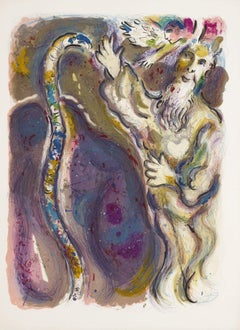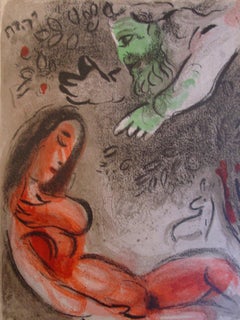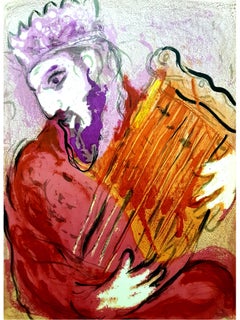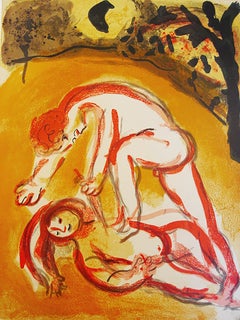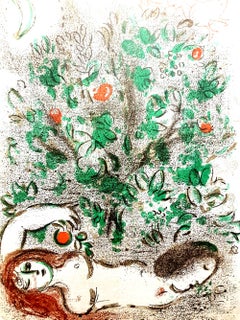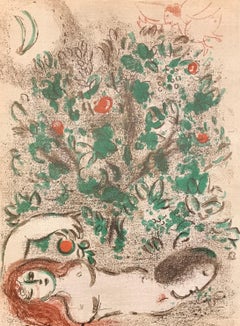Marc Chagall Art
Described by art critic Robert Hughes as "the quintessential Jewish artist of the twentieth century," the Russian-French modernist Marc Chagall worked in nearly every artistic medium. Influenced by Symbolism, Fauvism, Cubism and Surrealism, he developed his own distinctive style, combining avant-garde techniques and motifs with elements drawn from Eastern European Jewish folk art.
Born Moishe Segal in 1887, in Belarus (then part of the Russian empire), Chagall is often celebrated for his figurative paintings, but he also produced stained-glass windows for the cathedrals of Reims and Metz, in France; for the United Nations, in New York; and for the Hadassah Hospital in Jerusalem, as well as book illustrations, stage sets, ceramics, tapestries and fine-art prints. Characterized by a bold color palette and whimsical imagery, his works are often narrative, depicting small-village scenes and quotidian moments of peasant life, as in his late painting The Flight into Egypt from 1980.
Before World War I, Chagall traveled between St. Petersburg, Paris and Berlin. When the conflict broke out, he returned to Soviet-occupied Belarus, where he founded the Vitebsk Arts College before leaving again for Paris in 1922. He fled to the United States during World War II but in 1947 returned to France, where he spent the rest of his life. His peripatetic career left its mark on his style, which was distinctly international, incorporating elements from each of the cultures he experienced.
Marc Chagall remains one of the past century’s most respected talents — find his art on 1stDibs.
20th Century Modern Marc Chagall Art
Paper, Lithograph
1960s Marc Chagall Art
Lithograph
1950s Modern Marc Chagall Art
Lithograph
1960s Marc Chagall Art
Lithograph
1960s Modern Marc Chagall Art
Lithograph
1960s Marc Chagall Art
Lithograph
20th Century Modern Marc Chagall Art
Paper, Lithograph
20th Century Modern Marc Chagall Art
Paper, Lithograph
1960s Marc Chagall Art
Lithograph
20th Century Modern Marc Chagall Art
Paper, Lithograph
1940s Contemporary Marc Chagall Art
Lithograph
1960s Marc Chagall Art
Lithograph
1960s Expressionist Marc Chagall Art
Lithograph
1960s Surrealist Marc Chagall Art
Photogravure
1960s Surrealist Marc Chagall Art
Photogravure
1960s Marc Chagall Art
Lithograph
1960s Marc Chagall Art
Lithograph
1960s Surrealist Marc Chagall Art
Photogravure
1960s Surrealist Marc Chagall Art
Photogravure
1960s Surrealist Marc Chagall Art
Photogravure
1960s Surrealist Marc Chagall Art
Lithograph
1960s Surrealist Marc Chagall Art
Photogravure
1960s Surrealist Marc Chagall Art
Photogravure
1960s Surrealist Marc Chagall Art
Lithograph
1960s Surrealist Marc Chagall Art
Lithograph
1960s Surrealist Marc Chagall Art
Lithograph
1960s Surrealist Marc Chagall Art
Lithograph
1960s Marc Chagall Art
Lithograph
1960s Surrealist Marc Chagall Art
Photogravure
1960s Surrealist Marc Chagall Art
Photogravure
1960s Surrealist Marc Chagall Art
Photogravure
1960s Surrealist Marc Chagall Art
Photogravure
1960s Surrealist Marc Chagall Art
Photogravure
1960s Marc Chagall Art
Lithograph
20th Century Modern Marc Chagall Art
Paper, Lithograph
1960s Marc Chagall Art
Lithograph
1960s Modern Marc Chagall Art
Lithograph
1960s Modern Marc Chagall Art
Lithograph
1950s Marc Chagall Art
Lithograph
Late 20th Century Marc Chagall Art
Screen
1920s Surrealist Marc Chagall Art
Etching
1960s Modern Marc Chagall Art
Lithograph
1960s Marc Chagall Art
Etching
20th Century Modern Marc Chagall Art
Paper, Lithograph
1950s Modern Marc Chagall Art
Lithograph
1960s Surrealist Marc Chagall Art
Lithograph
1960s Surrealist Marc Chagall Art
Lithograph
1960s Surrealist Marc Chagall Art
Lithograph
20th Century Modern Marc Chagall Art
Paper, Woodcut
1950s Marc Chagall Art
Lithograph
Mid-20th Century Contemporary Marc Chagall Art
Lithograph
1950s Marc Chagall Art
Lithograph
1960s Surrealist Marc Chagall Art
Lithograph
1960s Surrealist Marc Chagall Art
Lithograph
Late 20th Century Marc Chagall Art
Etching, Watercolor
1970s Marc Chagall Art
Etching, Aquatint
Early 20th Century Abstract Impressionist Marc Chagall Art
Lithograph
1950s Modern Marc Chagall Art
Lithograph
1950s Modern Marc Chagall Art
Etching
1960s Modern Marc Chagall Art
Etching, Aquatint
Marc Chagall art for sale on 1stDibs.
Artists Similar to Marc Chagall
- 1stDibs ExpertMarch 26, 2024Marc Chagall’s body of work is quite big. Over the course of his 75-year career, Chagall created approximately 10,000 pieces, including prints, paintings, book illustrations, stained glass windows and more.
The Russian-French modernist worked in nearly every artistic medium, and Chagall’s vibrant and densely colorful prints are known around the world. Characterized by a bold color palette and whimsical imagery, his works are often narrative, depicting small-village scenes and quotidian moments of peasant life, as in his late painting The Flight into Egypt from 1980.
On 1stDibs, find a selection of Marc Chagall art. - Did Marc Chagall use oil paint?1 Answer1stDibs ExpertMarch 22, 2022Yes, Marc Chagall used oil paint to produce many of his paintings. He also worked with gouaches and watercolors. Not just a painter, Chagall made stained glass windows, illustrations, prints, ceramics and other types of works throughout his life. Find a collection of Marc Chagall art on 1stDibs.
- 1stDibs ExpertMarch 22, 2022Yes, Marc Chagall migrated to the United States. The Jewish artist fled Europe during World War II, moving to New York City in 1941. He settled in France in 1947 and lived there until he died in 1985. On 1stDibs, shop a range of Marc Chagall art.
- What inspired Marc Chagall?1 Answer1stDibs ExpertMarch 22, 2022Many artists and things inspired Marc Chagall. Historians believe that his Jewish heritage and his hometown of Liozna, Belarus, served as sources of inspiration throughout his life. His work also displays the influence of surrealist, cubist, symbolist and fauve artists. On 1stDibs, shop a variety of Marc Chagall art.
- 1stDibs ExpertMarch 26, 2024Marc Chagall used a variety of materials in his art. The Russian-French modernist worked in nearly every artistic medium. Influenced by Symbolism, Fauvism, Cubism and Surrealism, Chagall developed his own distinctive style, combining avant-garde techniques and motifs with elements drawn from Eastern European Jewish folk art.
Chagall produced magnificent stained-glass windows for structures in France, Israel, Germany and the United States. Additionally, his lively paintings of Paris are revered all over the world. Chagall had created etchings of Russian life during the 1920s but would explore printmaking later more deeply, during the 1950s, when he sought guidance from veteran lithographer Charles Sorlier, who became a friend and collaborator.
Find authentic Marc Chagall art on 1stDibs. - Where did Marc Chagall live?1 Answer1stDibs ExpertMarch 22, 2022Marc Chagall lived many places over the course of his life. He was born in Liozna, Belarus, on July 7, 1887. When he began working as an artist, he lived and worked in Saint Petersburg, Russia; Paris, France; and Berlin, Germany. During World War II, he relocated to the U.S. and then returned to Paris where he primarily resided until his death in 1985. On 1stDibs, find a variety of Marc Chagall art.
- What is Marc Chagall famous for?1 Answer1stDibs ExpertMarch 26, 2024Marc Chagall is famous for his art. He is one of the best known artists of the 20th century.
Chagall produced magnificent stained-glass windows for structures in France, Israel, Germany and the United States, and his lively paintings of Paris are revered all over the world. The Russian-French modernist worked in nearly every artistic medium. Influenced by Symbolism, Fauvism, Cubism and Surrealism, Chagall developed his own distinctive style, combining avant-garde techniques and motifs with elements drawn from Eastern European Jewish folk art.
Find authentic Marc Chagall prints and paintings on 1stDibs. - Who is Marc Chagall?1 Answer1stDibs ExpertMarch 22, 2022Marc Chagall was a painter, illustrator, glass artisan, print maker and set designer who made a lasting impact on modern art. He was born on July 7, 1887, in Liozna, Belarus, and died on March 28, 1985, in Saint Paul de Vence, France. On 1stDibs, shop a selection of Marc Chagall art.
- Where was Marc Chagall born?1 Answer1stDibs ExpertMarch 22, 2022Marc Chagall was born in Liozna, Belarus on July 7, 1887. He went on to become one of the most influential artists of the 20th century, creating works that drew from the movements of Cubism, Surrealism and Fauvism. On 1stDibs, find a selection of Marc Chagall art.
- When was Marc Chagall born?1 Answer1stDibs ExpertMarch 22, 2022Marc Chagall was born on July 7, 1887, in Liozna, Belarus. He was an influential artist who worked in a variety of mediums, including paint, stained glass and illustrations. Chagall died on March 28, 1985, in Saint Paul de Vence, France. On 1stDibs, find a collection of Marc Chagall art.
- How do I pronounce Marc Chagall?1 Answer1stDibs ExpertMarch 22, 2022To pronounce Marc Chagall, say "Mark Shu-GALL." The artist's real name was Moishe Shagal. Although the artist changed his name, he referenced his heritage in many works by including fish to represent his father who worked as a herring merchant. Shop a variety of Marc Chagall art on 1stDibs.
- 1stDibs ExpertFebruary 7, 2024Marc Chagall painted around 10,000 works during the course of his 75-year career. The Russian-French modernist worked in nearly every artistic medium. Influenced by Symbolism, Fauvism, Cubism and Surrealism, he developed his own distinctive style, combining avant-garde techniques and motifs with elements drawn from Eastern European Jewish folk art. On 1stDibs, find a selection of Marc Chagall art.
- 1stDibs ExpertMarch 26, 2024Yes, Marc Chagall worked in the Expressionist style, but he is associated with a range of modes and was inspired by various styles.
Chagall's lithographs as well as his other prints and paintings widely influenced the fantastic imagery of Surrealism and other movements of the 20th century. Known for his dreamlike creations inspired by folk art, Chagall drew on the colors and forms introduced by Cubism and Fauvism for a distinctive style all his own.
Expressionist artists experimented in paintings and prints with skewed perspectives, abstraction and unconventional, bright colors to portray how isolating and anxious the world felt rather than how it appeared. You can certainly detect the trademark bright colors and dramatic, exaggerated brushstrokes of Expressionism reflected in Chagall’s works such as his Vision of Paris and I and the Village.
Find a selection of Marc Chagall art on 1stDibs. - How do I collect Marc Chagall?1 Answer1stDibs ExpertMarch 26, 2024To collect Marc Chagall art, seek out works from well known and respected sources. When it comes to making an investment of any kind, it’s important to conduct research and only work with reputable sellers. You can shop the collections of art dealers, auction houses and trusted online platforms to find authentic Marc Chagall paintings, prints and other works.
There are many reasons to collect art. A meaningful collection of art should help a residence feel more like itself. Buy art that speaks to you. Take your time when you’re shopping for art, and choose works that will resonate with you.
Shop Marc Chagall art on 1stDibs. - 1stDibs ExpertOctober 15, 2024To tell if a Chagall print is real, experts recommend having a certified appraiser or experienced art dealer evaluate your piece. Fewer than 5% of Chagall's prints are signed and numbered, and counterfeiters have taken advantage of this and flooded the market with many convincing replicas. As a result, it can be very difficult to authenticate an original Chagall without experience and training. On 1stDibs, find a collection of Marc Chagall art.
- 1stDibs ExpertApril 5, 2022One of Marc Chagall’s most known works is entitled I and the Village. His style mixes bold colors in both the cubism and fauvism style. Shop a selection of Marc Chagall’s pieces from some of the world’s top art dealers on 1stDibs.
- 1stDibs ExpertSeptember 28, 2021A Marc Chagall painting is likely worth anywhere between $50,000 to $70,000 according to current estimates. Marc Chagall is a Russian-French artist of Belarusian Jewish origin who is credited to be among the pioneering modernists. Adept in several styles and techniques, Chagall was best-known for creating stain-glass, tapestries and murals apart from paintings. On 1stDibs, find a variety of Marc Chagall paintings.
- 1stDibs ExpertMarch 26, 2024Yes, Marc Chagall personally signed some of his bookplates. Other bookplate illustrations created by the artist bear a reproduction of his signature. Many of the signed versions come from the collections of notable historical figures, including Nicholas II, the last Russian czar. Find signed Marc Chagall lithographs on 1stDibs.
